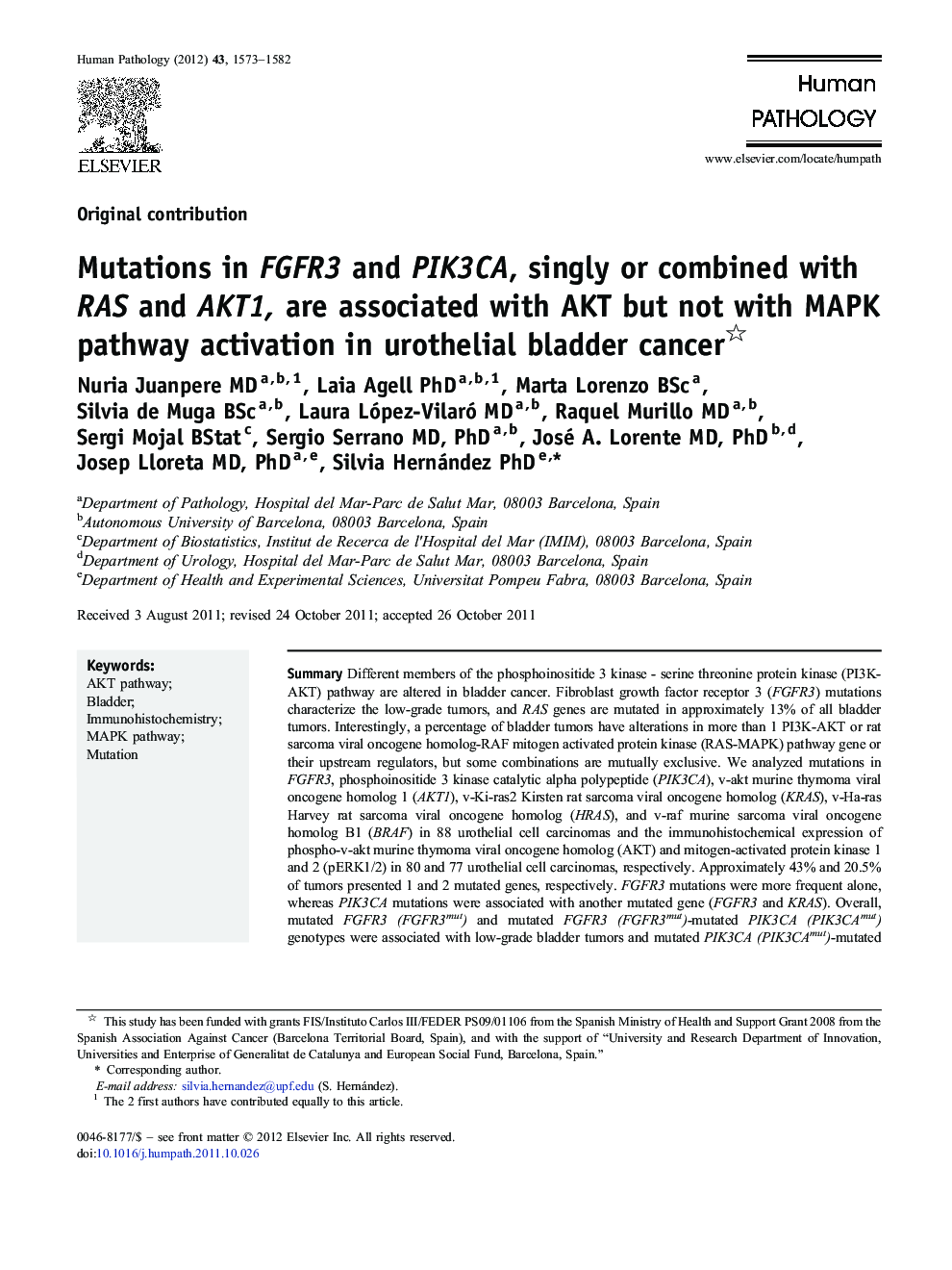| کد مقاله | کد نشریه | سال انتشار | مقاله انگلیسی | نسخه تمام متن |
|---|---|---|---|---|
| 4133120 | 1271410 | 2012 | 10 صفحه PDF | دانلود رایگان |

SummaryDifferent members of the phosphoinositide 3 kinase - serine threonine protein kinase (PI3K-AKT) pathway are altered in bladder cancer. Fibroblast growth factor receptor 3 (FGFR3) mutations characterize the low-grade tumors, and RAS genes are mutated in approximately 13% of all bladder tumors. Interestingly, a percentage of bladder tumors have alterations in more than 1 PI3K-AKT or rat sarcoma viral oncogene homolog-RAF mitogen activated protein kinase (RAS-MAPK) pathway gene or their upstream regulators, but some combinations are mutually exclusive. We analyzed mutations in FGFR3, phosphoinositide 3 kinase catalytic alpha polypeptide (PIK3CA), v-akt murine thymoma viral oncogene homolog 1 (AKT1), v-Ki-ras2 Kirsten rat sarcoma viral oncogene homolog (KRAS), v-Ha-ras Harvey rat sarcoma viral oncogene homolog (HRAS), and v-raf murine sarcoma viral oncogene homolog B1 (BRAF) in 88 urothelial cell carcinomas and the immunohistochemical expression of phospho-v-akt murine thymoma viral oncogene homolog (AKT) and mitogen-activated protein kinase 1 and 2 (pERK1/2) in 80 and 77 urothelial cell carcinomas, respectively. Approximately 43% and 20.5% of tumors presented 1 and 2 mutated genes, respectively. FGFR3 mutations were more frequent alone, whereas PIK3CA mutations were associated with another mutated gene (FGFR3 and KRAS). Overall, mutated FGFR3 (FGFR3mut) and mutated FGFR3 (FGFR3mut)-mutated PIK3CA (PIK3CAmut) genotypes were associated with low-grade bladder tumors and mutated PIK3CA (PIK3CAmut)-mutated KRAS (KRASmut) and mutated AKT1 (AKT1mut) were only present in high-grade tumors. There are no mutated FGFR3 (FGFR3mut)-mutated RAS (RASmut) nor mutated PIK3CA (PIK3CAmut)-mutated AKT1 (AKT1mut) combinations. Fifty percent and 56% of tumors showed high levels of pAKT and pERK1/2, respectively. High levels of pAKT were associated with total mutations, FGFR3mut, and PIK3CAmut tumors but not with tumor grade or stage. Wild-type tumors presented significantly higher pERK1/2 expression. Mutations in FGFR3 and FGFR3-PIK3CA but not single PIK3CA mutations characterize low-grade bladder tumors. Single FGFR3 or PIK3CA mutations and the different mutation combinations FGFR3-PIK3CA/AKT1 and PIK3CA-RAS can activate the AKT but not the MAPK pathway. Other genes different from FGFR3 may be related with the pERK activation in bladder tumors.
Journal: Human Pathology - Volume 43, Issue 10, October 2012, Pages 1573–1582